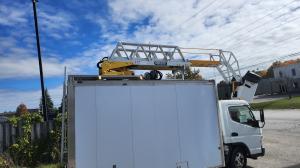Sign bases ‘parked’ along Alberta pipeline for surveillance
 Eric Hamelin, a wildlife biologist consulting for oil and natural gas exploration and production, recently turned to the rubber bases of parking lot signs to solve a surveillance problem for an above-ground pipeline running through northern Alberta.
Eric Hamelin, a wildlife biologist consulting for oil and natural gas exploration and production, recently turned to the rubber bases of parking lot signs to solve a surveillance problem for an above-ground pipeline running through northern Alberta.
Working for Amec, which offers engineering and project management services to oil, gas, mining, energy and infrastructure businesses around the world, Hamelin is tasked with monitoring activity around pipelines for wildlife movement.
“We normally mount remote cameras on trees, but this pipeline has a clear right-of-way, with nothing to use for mounting,” he explains.
Normally, the situation could be handled by pounding steel posts 0.9 to 1.2 m (3 to 4 ft) into the ground, but there was insufficient time in this instance to check first for any electrical cables or other utilities buried underground.
“The job order for construction was received late, so there was a tight deadline to meet,” says Hamelin. “There was no time for a ground disclosure.”
As it happened, a site contractor working on the project noticed a durable rubber base beneath an aluminum traffic sign while driving through a parking lot and suggested it as alternative method for mounting the cameras.
While portable and semi-permanent signs with rubber bases are common in many environments, including grocery stores, university campuses, hospitals, airports, plazas, shopping malls, parking garages, pedestrian crosswalks and construction sites, it took some creative thinking to bring the same concept to the pipeline project.
Hamelin looked into the idea to ensure the sign bases would be stable enough to handle the surveillance equipment. He contacted RubberForm Recycled Products and tested a sample base made from post-consumer tire rubber and plastic for the camera-mounting application.
“We did some research and discovered it was a good solution to the problem,” he says. “The project timeline was maintained, which kept expenses in line.”
While the chosen base was heavy enough to remain solidly in position, it was also light enough to be tipped and rolled, which meant Hamelin’s cameras could be adjusted from time to time as needed.
Amec was able to meet its deadlines and the sign bases continue to do their job alongside the pipeline route today.


